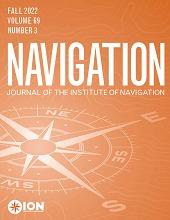Research ArticleOriginal Article
Open Access
ONCLE (One Clock Ensemble) for Galileo’s Next-Generation Robust Timing System
Qinghua Wang and Pascal Rochat
NAVIGATION: Journal of the Institute of Navigation September 2022, 69 (3) navi.536; DOI: https://doi.org/10.33012/navi.536
Qinghua Wang
Orolia Switzerland SA (Spectratime) 2000 Neuchâtel, Switzerland
Pascal Rochat
Orolia Switzerland SA (Spectratime) 2000 Neuchâtel, Switzerland

REFERENCES
- ↵
- Bertacco, E. K.,
- Calonico, D.,
- Cantoni, E.,
- Cerretto, G.,
- Costa, R.,
- Fiasca, F.,
- Formichella, V.,
- Levi, F.,
- Mura, A.,
- Perucca, A.,
- Pizzocaro, M.,
- Pollastri, F.,
- Sellone, M.,
- Sesia, I.,
- Signorile, G.,
- Terzi, P.,
- Thai, T. T.,
- Costanzo, G. A., &
- Rovera, G. D.
- ↵
- Brown, K. R.
- ↵
- European Space Agency (ESA)
- ↵
- Felbach, D.,
- Heimbuerger, D.,
- Herre, P., &
- Rastetter, P.
- ↵
- Galleani, L., &
- Tavella, P.
- ↵
- Galleani, L.,
- Signorile, G.,
- Formichella, V., &
- Sesia, I.
- ↵
- Huang, X.,
- Gong, H., &
- Ou, G.
- ↵
- Khare, A.,
- Arora, R.,
- Banik, A., &
- Mehta, S. D.
- ↵
- Krauss, P. A.,
- Zenzinger, A., &
- Fischer, S.
- ↵
- Morante, Q.,
- Cretoni, D.,
- Putortì, G.,
- Varriale, E.,
- Blanchi, M.,
- Cantelmo, C.,
- Baig, J. F.,
- Nogues, J. F.,
- Aouad, A. T.,
- Siccardi, M.,
- Mudrack, A., &
- Schlarmann, B.
- ↵
- Riley, W. J.
- ↵
- Rochat, P.,
- Droz, F.,
- Wang, Q., &
- Froidevaux, S.
- ↵
- Signorile, G.
- ↵
- Soualle, F.,
- Beck, T.,
- Trautenberg, H.,
- Felbach, D.,
- Stopfucken, L.,
- Wendel, J.,
- Fernandez, F. A.,
- Fernandez, A., &
- Sanchez Nogales, M.
- ↵
- Stehlin, X.,
- Wang, Q.,
- Jeanneret, F.,
- Rochat, P., &
- Detoma, E.
- ↵
- Stein, S. R.
- ↵
- Thomas, C.,
- Wolf, P., &
- Tavella, P.
- ↵
- Trainotti, C.,
- Schmidt, T. D., &
- Furthner, J.
- ↵
- Wang, Q.,
- Rochat, P., &
- Stehlin, X.
- ↵
- Wang, Q., &
- Rochat, P.
- ↵
- Wang, Q.,
- Droz, F., &
- Rochat, P.
- ↵
- Wang, Q., &
- Rochat, P.
- ↵
- Zanello, R.,
- Blanch, M.,
- Piras, C.,
- Detoma, E.,
- Capetti, P.,
- Bellotti, A., &
- Villabruna, D.
- ↵
- Zenzinger, A.,
- Bartusch, T.,
- Kuehl, C.,
- Fischer, S., &
- Shrestha, A.
In this issue
NAVIGATION: Journal of the Institute of Navigation
Vol. 69, Issue 3
Fall 2022
ONCLE (One Clock Ensemble) for Galileo’s Next-Generation Robust Timing System
Qinghua Wang, Pascal Rochat
NAVIGATION: Journal of the Institute of Navigation Sep 2022, 69 (3) navi.536; DOI: 10.33012/navi.536
Jump to section
Related Articles
Cited By...
- No citing articles found.






